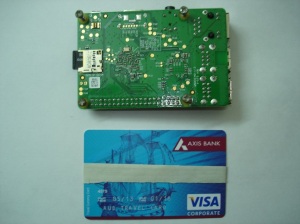Raspberry Pi- my latest ‘computer’
Raspberry Pi has got worldwide attention in past few years. I was following it for a long time but recently I finally decided to purchase Raspberry Pi Model B+ for myself in India from rsdelivers. It arrived the next day in nice little packaging.
Since then the amazing computer has kept surprising me not only with the powerful hardware but also the extensive community support that it enjoys. No wonder why internet is flooded with so many blogs and information on it. The first thing I did was, I have to admit, I compared it with a credit card! Oh Yes, it’s true – it’s a credit card sized computer.
Next I went ahead and installed my first OS using NOOBS. I used my Ubuntu laptop, Sony XPERIA Android phone and an old Windows XP desktop do one or the other task related to setting up the Pi.
The hardware
Power supply
800mA USB phone charger. Don’t be surprised the power consumption is ~4 Watts.
Storage
4GB Micro SD that came along with a phone
Display and Sound
LG LED TV connected with HDMI
Internet
LAN cable connected directly to the modem cum router
Keyboard and Mouse
Logitech Wireless combo. I’ve been using a wireless mouse for my office laptop for many years now, but never had seen a working wireless keyboard before. I was a bit worried about power consumption for a wireless keyboard, but I liked the wireless combo because it consumes single USB port for both keyboard and mouse. So no worries about additional power driven from the Pi board.
Connectors
All in one USB card reader.
The software
This is where a series of challenges began but I never remained stuck for long. All help is already out there on the internet.
Download OS
As per official documentation, the easiest way to start is with NOOBS installer. As soon as I had ordered the Pi, I started with setting up the Micro SD card with NOOBS installer. After downloading the installer, the first challenge I faced was – though I had the laptop, I didn’t have the Micro SD adapter with me at that time. So I inserted the SD card in Android phone and enabled storage mode and connected the phone with USB cable to the Ubuntu laptop. My first step concluded and NOOBS installer got downloaded in the SD card.
Install OS
Now with me, I had the Pi, MMC card with the setup, LAN connectivity, HDMI. I had thought I could use the keyboard and mouse from the 15 years old desktop from my graduation days but, alas, that’s really too old now! Not only the OS Windows XP is no longer supported, but even the hardware parts are not compatible with present generation of computing machines. The keyboard is PS/2 type and Pi expects a USB one. I was stuck. I had installed operating systems many times earlier, but never imagined I’d google – ‘how to install OS on Rasberry Pi without Keyboard/Mouse’ and to my utter surprise, I was not the first one thinking that way. It turned out that Raspbian OS can be installed headlessly on Raspberry Pi. I plugged in all the i/o peripherals of my ‘computer’ and turned on the power supply. Its only then I realized why RPi official site says NOOBS is very simple installer. It doesn’t ask for anything, the installer finished up without any keyboard input! At this point, I could see the nice GUI on my TV. Well, the easy installer was enough to impress me to shell out few more bucks and I ordered online a wireless keyboard and mouse combo. Wait, do you think you can wait till keyboard and mouse arrive to actually deep dive into your new computer? Nah. If the OS can be installed headlessly, why not about RDPing into it to check out how Raspbian looks like. I had ditched Windows 7 for Ubuntu as it consumed most of my SSD space in the laptop. Using it for almost a year, I was confident of playing around with another Linux OS- Raspbian.
Essential apps
To connect Raspberry Pi remotely from Windows, the app is called xrpd. That’s cool, but again, how would you install it without the keyboard, huh? For Linux users, it’s not a big deal. I installed JuiceSSH, the first app that showed up on searching SSH client in Android Play on my literally smart Android smartphone. Connection was seamless and within minutes I was firing remote commands from my phone onto the Pi. Installation of xrdp is done via sudo apt-get install xrdp and that’s it. This is all that’s required to RDP to Pi. Now I could use my Windows desktop to install different packages- Chromium and Iceweasel- the Debian equivalents of Chrome and Firefox respectively. I installed Synaptic- a GUI based package manager for Linux to avoid firing sudo apt-get commands for installation of packages.



